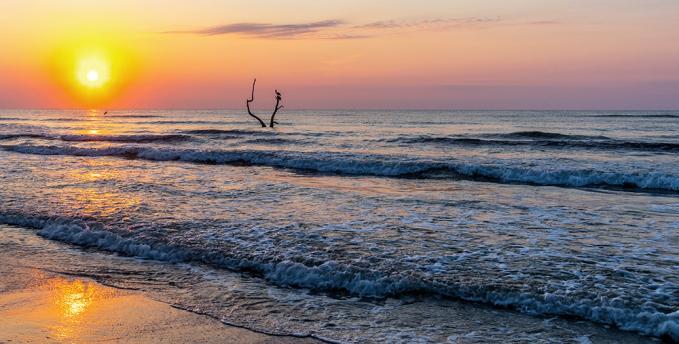Getting to Padre Island National Seashore
- By Rebecca Latson - December 2nd, 2024 11:11am

Sunrise over Malaquite Beach, Padre Island National Seashore / Rebecca Latson
Contributing photographer and writer for the National Parks Traveler since 2012, Rebecca Latson has ventured out to units of the U.S. National Park System, as well as national parks within Canada, on behalf of the Traveler. With her writing and photography, Rebecca authors the Traveler's monthly Photography In The National Parks column as well as various other national park-related articles (hiking, itineraries, photography guides, quizzes) for the Traveler.
Padre Island National Seashore in Texas was made for sunrises. Established in 1962 to protect 66 miles (106.2km) of coastline along the Gulf of Mexico, this national seashore protects five species of sea turtle which nest or forage along the beaches and dunes, including one of the most endangered sea turtles in the world: the Kemp’s ridley. Padre Island is also a birder’s paradise, with over 380 species calling this place home or migrating through the area during different times of year.
During 2023, over 550,000 visitors traveled to this national seashore along the warm waters of the Gulf of Mexico to camp, beachcomb, fish, boat, horseback ride, scuba, snorkel, windsurf, swim, attend a Kemp’s ridley hatchling release, and explore remote areas of the park by driving down the beach (4-wheel drive recommended). It’s an especially popular location for students enjoying their annual Spring Break.
In addition to the birds, a proliferation of wildlife exists within the boundaries of this national seashore, including coyotes, deer, rattlesnakes, ghost crabs, 149 species of fish, and a multitude of insects, as well as scorpions and giant centipedes measuring 6.5-8 in (16.5-20.3 cm).
There’s plenty of history to be learned at Padre Island. At various times, four different nations claimed this landscape: Spain, Mexico, the Republic of Texas, and the United States. What is now the national seashore was once used almost solely for ranching. During World War II to 1960, a Navy bombing range existed on the northern section of the island. Tourism sprang up around the early 1920s to create the town of South Padre Island as well as this national seashore. Oil and gas exploration and exploitation began in the 1950's and you can see offshore oil rigs from Malaquite Beach, near the park’s visitor center.
It's not all about the beach at Padre Island, however. Most of the island’s terrain consists of coastal prairie interspersed with ephemeral marshes and dune fields. The coastal prairie is a type of tallgrass prairie similar to the tallgrass prairie of the Midwest United States, and it’s where you will find year-round color from such wildflowers as the scarlet pea, railroad vine, sunflower, and prickly pear cactus, to name a few of the 400 species of flowering plants you might spot during a visit.
If you don’t feel like primitive camping on the beach or at this national seashore’s two developed campgrounds, there’s plenty of brick-and-mortar lodging within the towns of South Padre Island and nearby Corpus Christi, where you will also find a variety of dining options.
Side excursions around the area include Port Aransas National Wildlife Refuge, Mustang Island State Park, the Texas State Aquarium, Port Isabel Lighthouse State Historic Site, Brazos Island State Park, and the historic, bustling city of San Antonio.
The pages below will help you plan your visit to Padre Island National Seashore, providing both helpful as well as interesting information and trivia.
Traveler's Choice For: beachcombing, birding, sunrises


National Parks Traveler is a 501(c) (3) nonprofit.


Here’s the definitive guide to National Park System campgrounds where RVers can park their rigs.
Our app is packed with RVing- specific details on more than 250 campgrounds in more than 70 national parks.
You’ll also find stories about RVing in the parks, tips helpful if you’ve just recently become an RVer, and useful planning suggestions.
